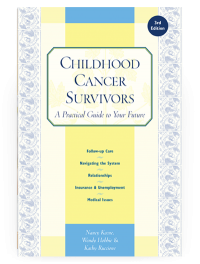Childhood Cancer Survivors
Early detection
Taking control of your risk for second cancers includes periodic surveillance, as well as making healthy lifestyle choices. Your healthcare provider should do a thorough assessment every year and discuss with you any risks you have for second cancers. The specific tests done are determined by an assessment that considers the treatment you received for childhood cancer, any past or current behaviors that affect your risk, and personal or family history of disease.
Your follow-up examinations should include updating your family medical history, with special attention to cancers that have developed in first-degree relatives (your mother, father, brothers, sisters, and children). This valuable information can be missed if family medical history is not updated at regular intervals.
If you were treated with radiation, the area that was irradiated should be visually inspected. Areas where scattered radiation may have occurred also need to be examined. For instance, children who had cranial radiation sometimes develop thyroid problems from the scatter. Therefore, the necks of these survivors should be palpated (felt by hand) yearly. The results of a thorough physical evaluation and preliminary screening determine the need for any additional tests. It’s very important that female survivors of Hodgkin lymphoma who had mantle radiation get frequent follow-up care that includes annual mammograms starting at age 25, or 8 years after radiation (whichever comes later). They also need to be taught breast self-examination because they can develop breast cancer at an early age.
I had Hodgkin’s disease when I was 15 and was treated with mantle radiation and ABVD (combination of four chemotherapy drugs). I find that knowing the possibilities helps me comply with appropriate measures—like breast self-exams, mammography (my first was at age 25), and lifestyle changes. Doing these things makes me feel more in control of my life—not that I can stop something from happening, but that perhaps I can notice a change early on and make a difference in terms of treatment or even survival. My thought is that a breast self-exam might mean I find a lump at 1.5 cm that could be 2.5 cm by the next physical exam. And that could mean a difference in my survival as well as my treatment. But I definitely don’t sit around and worry.
Routine yearly examinations will not detect all second cancers. Healthcare providers rely on you to bring any concerns or abnormalities to their attention. Try to feel confident in your ability to notice if something does not feel right. If you have an ache or a pain that does not go away, it should probably be checked out. If you notice a lump in the area of your body that was irradiated, go have it evaluated. It probably will not be cancer, but having it evaluated will provide either reassurance or an early detection of a problem—both good outcomes.
There are steps you can take to identify and treat second cancers. For example, you can have your physician remove very small skin cancers, and you can stay out of the sun or use sunscreen routinely. If you had retinoblastoma and were treated with radiation to the orbit, it makes sense to examine the socket yourself regularly for any changes. By examining the orbit regularly, you are taking good care of yourself and making an investment in your future. Another way to think of this issue is to try to find a place in your life for your cancer history. Don’t trivialize what’s happened to you and your family—it was a significant part of your life and shaped your interests and character. And yet, your cancer history is only one part of who you are.
I try to put cancer in its place. I’ve learned everything I can and I know what my risks are. I have a little drawer in the back of my mind that I put that knowledge in, then I close the drawer. I stay aware for the signs and symptoms, and if any arise, I’ll open that drawer and take action. But the rest of the time, I don’t worry about it.
Table of Contents
All Guides- 1. Survivorship
- 2. Emotions
- 3. Relationships
- 4. Navigating the System
- 5. Staying Healthy
- 6. Diseases
- 7. Fatigue
- 8. Brain and Nerves
- 9. Hormone-Producing Glands
- 10. Eyes and Ears
- 11. Head and Neck
- 12. Heart and Blood Vessels
- 13. Lungs
- 14. Kidneys, Bladder, and Genitals
- 15. Liver, Stomach, and Intestines
- 16. Immune System
- 17. Muscles and Bones
- 18. Skin, Breasts, and Hair
- 19. Second Cancers
- 20. Homage
- Appendix A. Survivor Sketches
- Appendix B. Resources
- Appendix C. References
- Appendix D. About the Authors
- Appendix E. Childhood Cancer Guides (TM)

